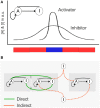Development of cell differentiation in the transition to multicellularity: a dynamical modeling approach
- PMID: 26157427
- PMCID: PMC4477168
- DOI: 10.3389/fmicb.2015.00603
Development of cell differentiation in the transition to multicellularity: a dynamical modeling approach
Abstract
Multicellularity has emerged and continues to emerge in a variety of lineages and under diverse environmental conditions. In order to attain individuality and integration, multicellular organisms must exhibit spatial cell differentiation, which in turn allows cell aggregates to robustly generate traits and behaviors at the multicellular level. Nevertheless, the mechanisms that may lead to the development of cellular differentiation and patterning in emerging multicellular organisms remain unclear. We briefly review two conceptual frameworks that have addressed this issue: the cooperation-defection framework and the dynamical patterning modules (DPMs) framework. Then, situating ourselves in the DPM formalism first put forward by S. A. Newman and collaborators, we state a hypothesis for cell differentiation and arrangement in cellular masses of emerging multicellular organisms. Our hypothesis is based on the role of the generic cell-to-cell communication and adhesion patterning mechanisms, which are two fundamental mechanisms for the evolution of multicellularity, and whose molecules seem to be well-conserved in extant multicellular organisms and their unicellular relatives. We review some fundamental ideas underlying this hypothesis and contrast them with empirical and theoretical evidence currently available. Next, we use a mathematical model to illustrate how the mechanisms and assumptions considered in the hypothesis we postulate may render stereotypical arrangements of differentiated cells in an emerging cellular aggregate and may contribute to the variation and recreation of multicellular phenotypes. Finally, we discuss the potential implications of our approach and compare them to those entailed by the cooperation-defection framework in the study of cell differentiation in the transition to multicellularity.
Keywords: cooperation; defection; differentiation; dynamical patterning modules; multicellularity; multiscale modeling.
Figures



Similar articles
-
Dynamical Patterning Modules, Biogeneric Materials, and the Evolution of Multicellular Plants.Front Plant Sci. 2018 Jul 16;9:871. doi: 10.3389/fpls.2018.00871. eCollection 2018. Front Plant Sci. 2018. PMID: 30061903 Free PMC article.
-
Dynamical patterning modules in plant development and evolution.Int J Dev Biol. 2012;56(9):661-74. doi: 10.1387/ijdb.120027mb. Int J Dev Biol. 2012. PMID: 23319343 Review.
-
The origins of multicellular organisms.Evol Dev. 2013 Jan;15(1):41-52. doi: 10.1111/ede.12013. Evol Dev. 2013. PMID: 23331916
-
Dynamical patterning modules and network motifs as joint determinants of development: Lessons from an aggregative bacterium.J Exp Zool B Mol Dev Evol. 2021 Apr;336(3):300-314. doi: 10.1002/jez.b.22946. Epub 2020 May 17. J Exp Zool B Mol Dev Evol. 2021. PMID: 32419346
-
The evolution of multicellularity and cancer: views and paradigms.Biochem Soc Trans. 2020 Aug 28;48(4):1505-1518. doi: 10.1042/BST20190992. Biochem Soc Trans. 2020. PMID: 32677677 Review.
Cited by
-
Why call it developmental bias when it is just development?Biol Direct. 2021 Jan 9;16(1):3. doi: 10.1186/s13062-020-00289-w. Biol Direct. 2021. PMID: 33422150 Free PMC article.
-
Unicellular-multicellular evolutionary branching driven by resource limitations.J R Soc Interface. 2022 Jun;19(191):20220018. doi: 10.1098/rsif.2022.0018. Epub 2022 Jun 1. J R Soc Interface. 2022. PMID: 35642429 Free PMC article.
-
A Morphospace Exploration Using a General Model of Development Reveals a Basic Set of Morphologies for Early Animal Development and Evolution.J Exp Zool B Mol Dev Evol. 2025 Mar;344(2):45-58. doi: 10.1002/jez.b.23279. Epub 2024 Dec 22. J Exp Zool B Mol Dev Evol. 2025. PMID: 39711075 Free PMC article.
-
Inaugural meeting of the Pan-American Society for Evolutionary Developmental Biology report: the importance of diversity in a multidisciplinary field.Evodevo. 2015 Dec 9;6(1):38. doi: 10.1186/s13227-015-0035-1. Evodevo. 2015. PMID: 40733855 Free PMC article.
-
Systems Medicine: The Application of Systems Biology Approaches for Modern Medical Research and Drug Development.Mol Biol Int. 2015;2015:698169. doi: 10.1155/2015/698169. Epub 2015 Aug 18. Mol Biol Int. 2015. PMID: 26357572 Free PMC article. Review.
References
-
- Armstrong P. B., Armstrong M. T. (1984). A role for fibronectin in cell sorting. J. Cell Sci. 69, 179–197. - PubMed
-
- Axelrod R. M. (2006). The Evolution of Cooperation (Revised ed.). New York, NY: Perseus Books Group.
LinkOut - more resources
Full Text Sources
Other Literature Sources

